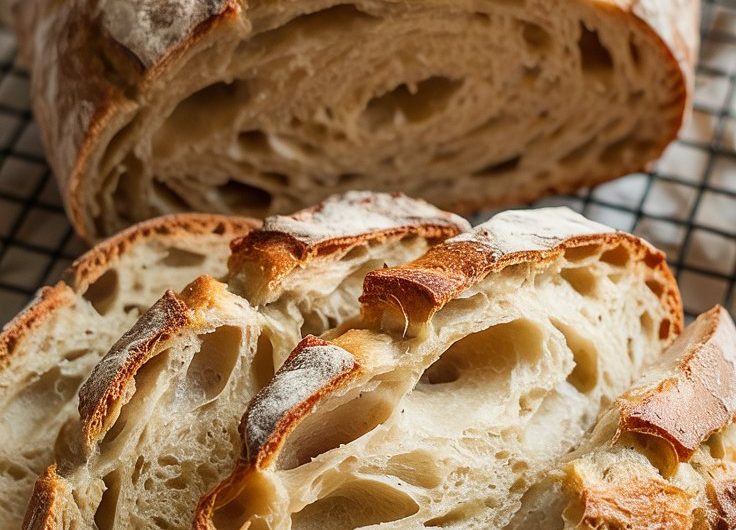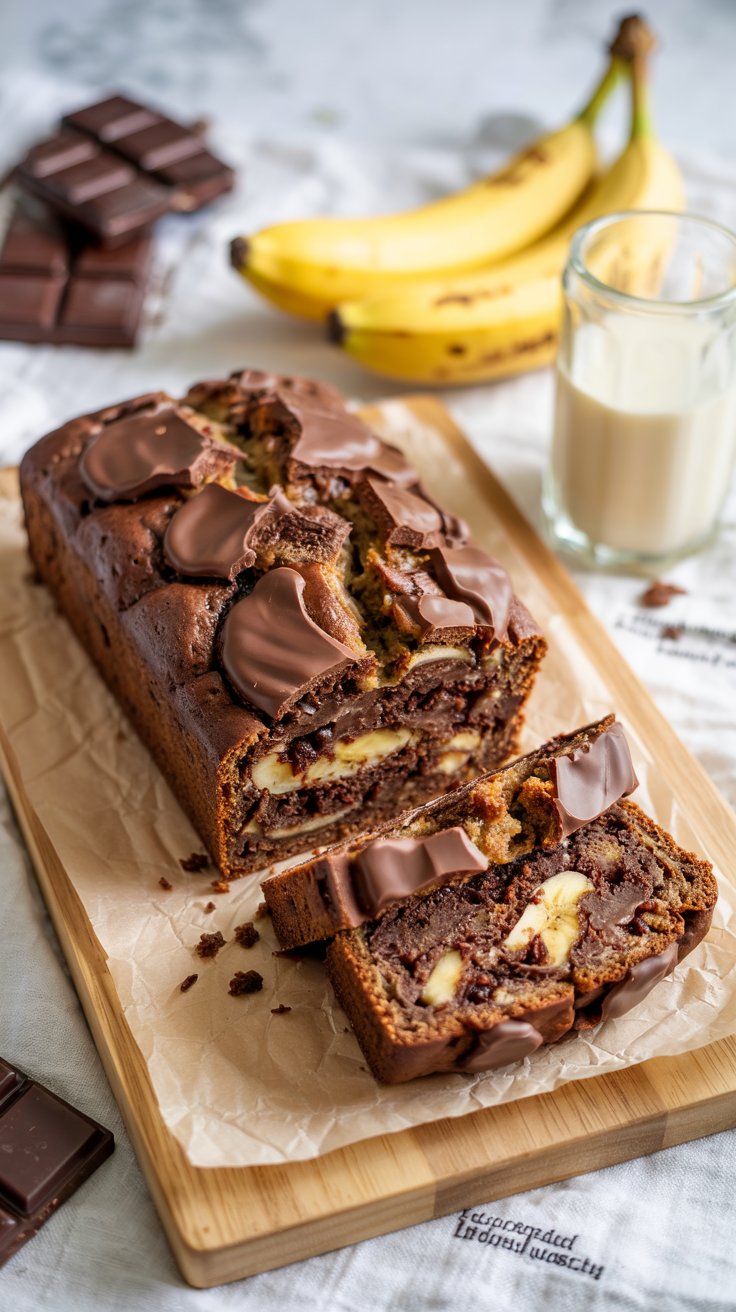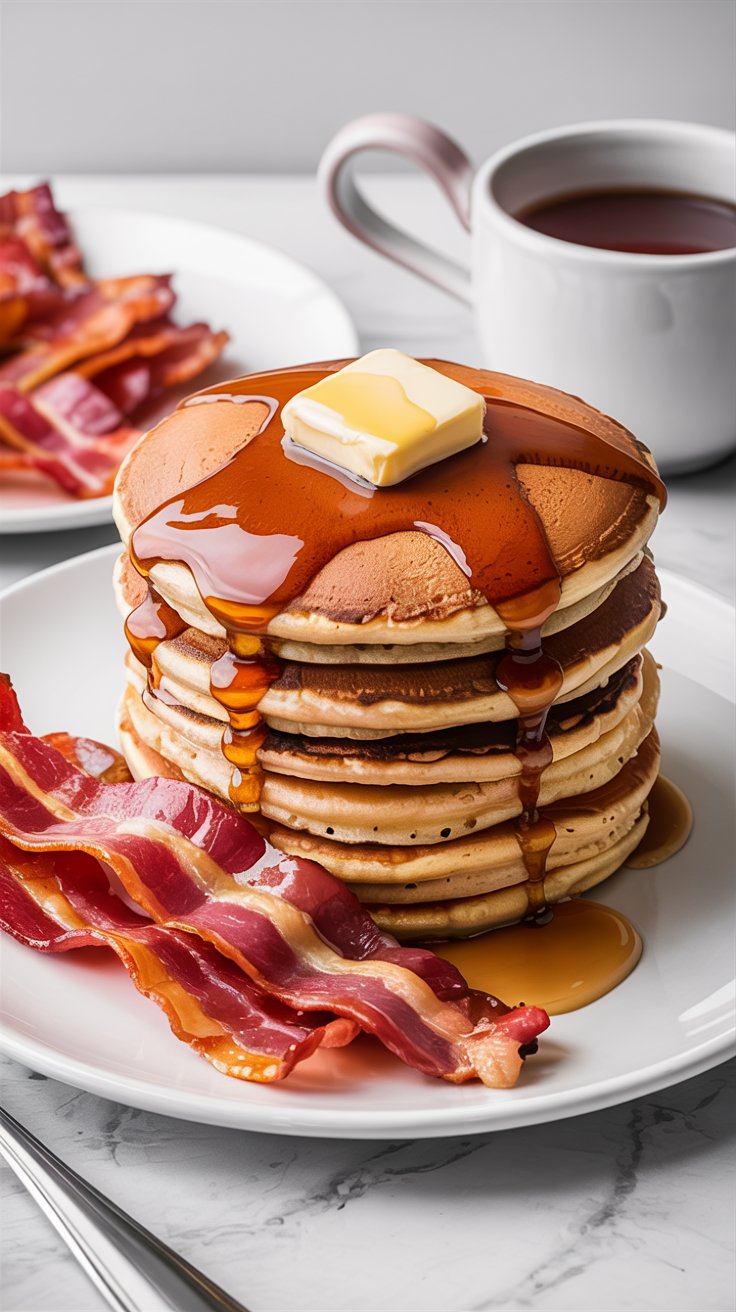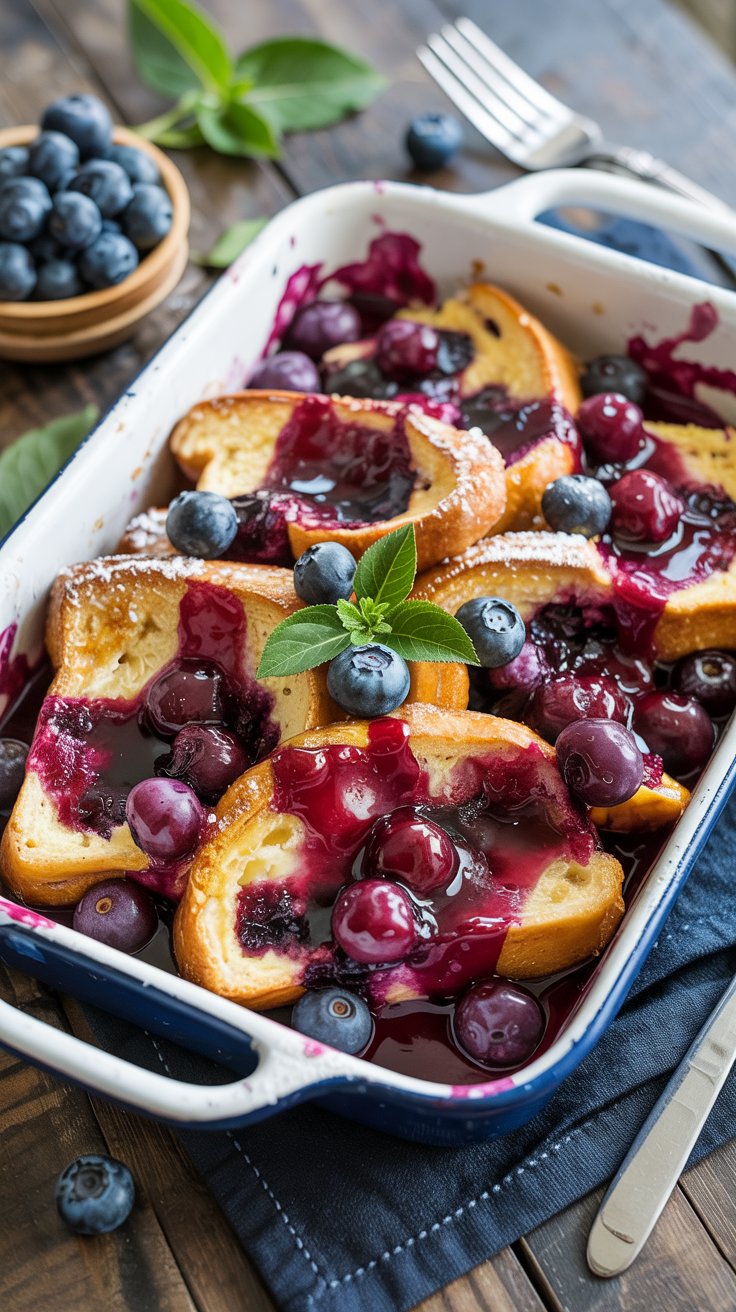Easy Homemade Bread
There’s something quietly satisfying about Easy Homemade Bread. No fancy gear, no rare ingredients, just a bowl, your hands, and a warm kitchen. This loaf is soft inside, golden at the edges, and perfect for toast, sandwiches, or that first slice with butter while it’s still a little warm. The process is simple and forgiving, which is exactly what makes it a great starting point if you’re new to bread… and a trusty standby if you’re not.
I like to mix the dough while the coffee brews, then let it rise while I get on with my day. It’s a calm kind of recipe. The dough does most of the work. Come back to it, give it a little shaping, let it rise again, then into the oven it goes. And when your kitchen starts to smell like a bakery — it’s hard to beat.
This makes one standard loaf that slices beautifully and keeps well. Nothing showy. Just good bread, the kind you’ll make again next week without thinking twice.
Ingredients for this Easy Homemade Bread
- 3 1/2 cups (420 g) all-purpose or bread flour, plus extra for dusting
- 1 cup plus 2 tablespoons (270 ml) warm water, about 105 to 110°F (40 to 43°C)
- 2 1/4 teaspoons (1 packet, 7 g) active dry yeast
- 1 tablespoon granulated sugar or honey
- 1 1/2 teaspoons fine salt
- 2 tablespoons unsalted butter, melted (or 2 tablespoons neutral oil)
- Optional: 1 egg beaten with 1 tablespoon water for a shinier crust
- Optional toppings: sesame seeds, poppy seeds, or a sprinkle of oats
Instructions
Proof the yeast. In a large mixing bowl, combine the warm water and sugar. Sprinkle the yeast over the top, stir once, and let it sit for 5 to 10 minutes until foamy. If nothing happens, your yeast may be old or the water temperature might be off — try again with fresh yeast.
Make the dough. Add 3 cups of the flour, the salt, and the melted butter. Stir with a wooden spoon until a shaggy dough forms. If it’s very sticky, add the remaining flour a little at a time until the dough pulls away from the sides of the bowl.
Knead. Turn the dough onto a lightly floured surface and knead for 8 to 10 minutes, until smooth and elastic. It should feel soft and slightly tacky, not wet. If you pinch a small piece and gently stretch it, you’ll see a thin, almost translucent membrane (that’s the windowpane test). Using a stand mixer with a dough hook works too — about 6 to 8 minutes on medium-low.
First rise. Lightly oil a clean bowl, place the dough inside, and turn it once to coat. Cover with a clean towel or plastic wrap and let it rise in a warm, draft-free spot until doubled in size, about 60 to 90 minutes. A slightly warm oven (turned off) or a sunny counter works well.
Shape the loaf. Gently deflate the dough and pat it into a rectangle, about the length of your loaf pan. Tightly roll it up from the short end, tucking the seams as you go. Pinch the seam closed. Place seam-side down in a greased 9 x 5-inch (23 x 13 cm) loaf pan.
Second rise. Cover and let the dough rise again until it crowns about 1 inch above the rim of the pan, 30 to 45 minutes depending on your kitchen temp. Near the end of this rise, preheat the oven to 375°F (190°C). If using, brush the top with the egg wash and sprinkle seeds.
Bake. Bake for 30 to 35 minutes, until the top is deep golden and the loaf sounds hollow when tapped on the bottom. If you have an instant-read thermometer, you’re looking for 200 to 205°F (93 to 96°C) in the center.
Cool. Turn the loaf out onto a rack and let it cool for at least 45 minutes before slicing. I know, it’s hard to wait. But this rest sets the crumb so your slices are tender and neat. The first slice with a pat of butter… worth the patience.
Little tip: If your dough feels tight or resists shaping, cover it and let it rest for 5 to 10 minutes, then try again. A short breather relaxes the gluten.
Cook and Prep Times
- Prep time: 15 minutes active, plus rising
- First rise: 60 to 90 minutes
- Shaping: 10 minutes
- Second rise: 30 to 45 minutes
- Bake time: 30 to 35 minutes
- Cooling: 45 to 60 minutes
- Total: About 3 to 4 hours, hands-on time roughly 25 minutes
- Yield: 1 loaf, about 12 slices
Nutritional information
These numbers are estimates for one of 12 slices, using all-purpose flour, 2 tablespoons butter, and 1 tablespoon sugar. Your exact values may vary with flour type and toppings.
- Calories: ~150 to 170
- Carbohydrates: ~29 g
- Protein: ~4 to 5 g
- Fat: ~3 to 4 g
- Fiber: ~1 to 2 g
- Sodium: ~220 to 260 mg
If you swap in oil for butter, the totals are similar. Using bread flour bumps protein slightly. Whole-wheat flour will add fiber and a bit more density; for a lighter texture, substitute only 1 cup of the flour with whole wheat the first time you try it.
Frequently asked questions
Can I use instant yeast instead of active dry yeast?
Instant yeast can be mixed directly with the dry ingredients, no proofing needed. Use the same amount, 2 1/4 teaspoons. Add the warm water and melted butter after combining the dry ingredients and mix as directed. The dough may rise a little faster, so keep an eye on it during both rises and move on as soon as it doubles and looks puffy.
What if I don’t have a stand mixer?
No problem. This loaf is very doable by hand. Stir with a wooden spoon until the dough comes together, then knead on a lightly floured counter for 8 to 10 minutes. It should transition from scrappy to smooth and springy. If the dough sticks a lot, dust with just a teaspoon of flour at a time. It’s easy to add too much and end up with a dense loaf, so go slow. I often set a timer, put on a podcast, and knead until the dough feels alive under my hands.
Why did my bread turn out dense or not rise well?
Three common culprits: old yeast, too much flour, or under-proofing. Check that your yeast foams in step one. When measuring flour, fluff it, spoon into the cup, and level — or better yet, weigh it. During the rises, let the dough double in size rather than watching the clock. If your kitchen is cool, it may need extra time. A warm spot and patience make a big difference. Also, resist slicing while it’s hot; cutting too soon compresses the crumb and makes it seem dense.
Storage: Wrap the cooled loaf in a clean towel or store in a bread box at room temperature for up to 3 days. For longer storage, slice and freeze in a zip-top bag, then toast straight from frozen. Morning toast, sorted.
Variations: Stir in 1 tablespoon of milk powder for a softer crumb, brush with melted butter after baking for tenderness, or sprinkle the top with oats before baking for a rustic look. If you like herbs, fold in 1 to 2 teaspoons of dried rosemary or Italian seasoning during mixing. Tiny tweaks, big payoff.
And that’s it. Easy Homemade Bread you can make on a regular day, no fuss. The kind of loaf that makes the kitchen feel welcoming the minute it hits the oven.
Easy Homemade Bread
12
servings15
minutes35
minutes170
kcalThere’s something quietly satisfying about Easy Homemade Bread. No fancy gear, no rare ingredients, just a bowl, your hands, and a warm kitchen. This loaf is soft inside, golden at the edges, and perfect for toast, sandwiches, or that first slice with butter while it’s still a little warm. The process is simple and forgiving, which is exactly what makes it a great starting point if you’re new to bread… and a trusty standby if you’re not.
Ingredients
3 1/2 cups (420 g) all-purpose or bread flour, plus extra for dusting
1 cup plus 2 tablespoons (270 ml) warm water, about 105 to 110°F (40 to 43°C)
2 1/4 teaspoons (1 packet, 7 g) active dry yeast
1 tablespoon granulated sugar or honey
1 1/2 teaspoons fine salt
2 tablespoons unsalted butter, melted (or 2 tablespoons neutral oil)
Optional: 1 egg beaten with 1 tablespoon water for a shinier crust
Optional toppings: sesame seeds, poppy seeds, or a sprinkle of oats
Instructions
- Proof the yeast. In a large mixing bowl, combine the warm water and sugar. Sprinkle the yeast over the top, stir once, and let it sit for 5 to 10 minutes until foamy. If nothing happens, your yeast may be old or the water temperature might be off — try again with fresh yeast.
- Make the dough. Add 3 cups of the flour, the salt, and the melted butter. Stir with a wooden spoon until a shaggy dough forms. If it’s very sticky, add the remaining flour a little at a time until the dough pulls away from the sides of the bowl.
- Knead. Turn the dough onto a lightly floured surface and knead for 8 to 10 minutes, until smooth and elastic. It should feel soft and slightly tacky, not wet. If you pinch a small piece and gently stretch it, you’ll see a thin, almost translucent membrane (that’s the windowpane test). Using a stand mixer with a dough hook works too — about 6 to 8 minutes on medium-low.
- First rise. Lightly oil a clean bowl, place the dough inside, and turn it once to coat. Cover with a clean towel or plastic wrap and let it rise in a warm, draft-free spot until doubled in size, about 60 to 90 minutes. A slightly warm oven (turned off) or a sunny counter works well.
- Shape the loaf. Gently deflate the dough and pat it into a rectangle, about the length of your loaf pan. Tightly roll it up from the short end, tucking the seams as you go. Pinch the seam closed. Place seam-side down in a greased 9 x 5-inch (23 x 13 cm) loaf pan.
- Second rise. Cover and let the dough rise again until it crowns about 1 inch above the rim of the pan, 30 to 45 minutes depending on your kitchen temp. Near the end of this rise, preheat the oven to 375°F (190°C). If using, brush the top with the egg wash and sprinkle seeds.
- Bake. Bake for 30 to 35 minutes, until the top is deep golden and the loaf sounds hollow when tapped on the bottom. If you have an instant-read thermometer, you’re looking for 200 to 205°F (93 to 96°C) in the center.
- Cool. Turn the loaf out onto a rack and let it cool for at least 45 minutes before slicing. I know, it’s hard to wait. But this rest sets the crumb so your slices are tender and neat. The first slice with a pat of butter… worth the patience.
Notes
- Little tip: If your dough feels tight or resists shaping, cover it and let it rest for 5 to 10 minutes, then try again. A short breather relaxes the gluten.








